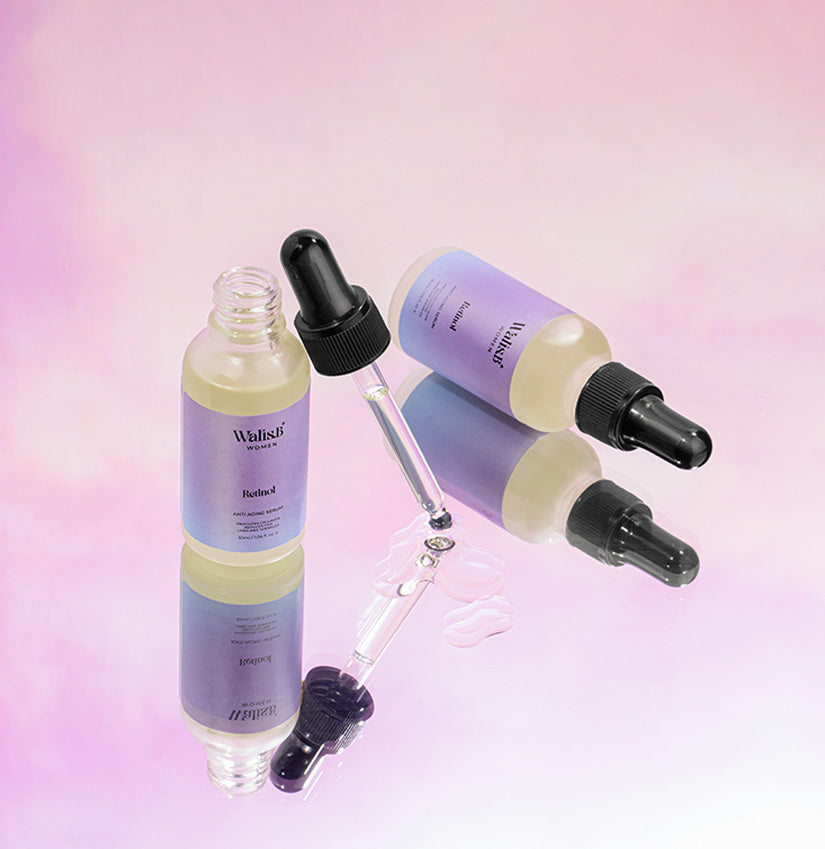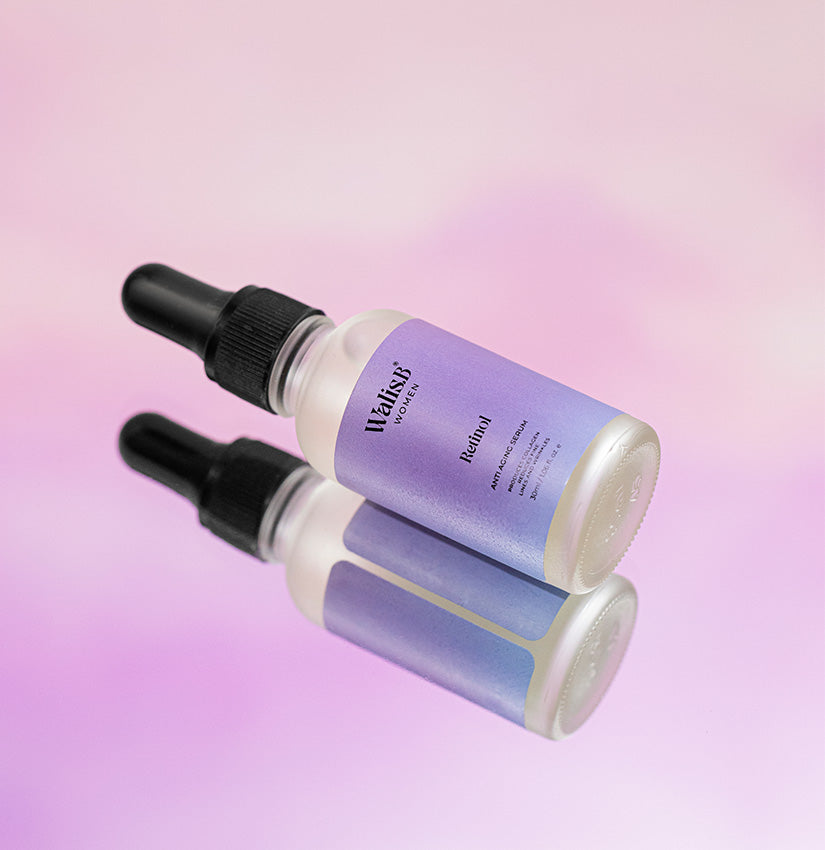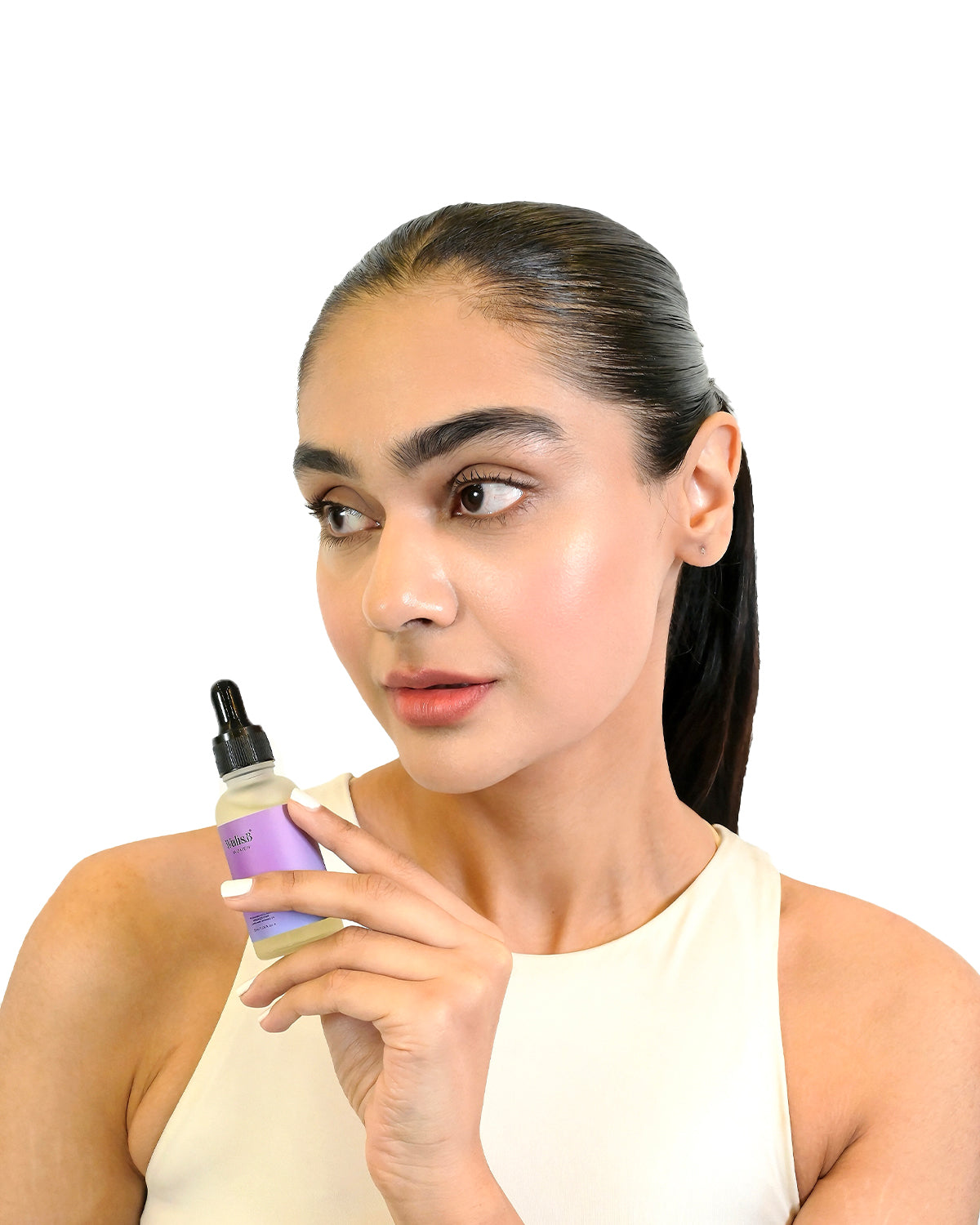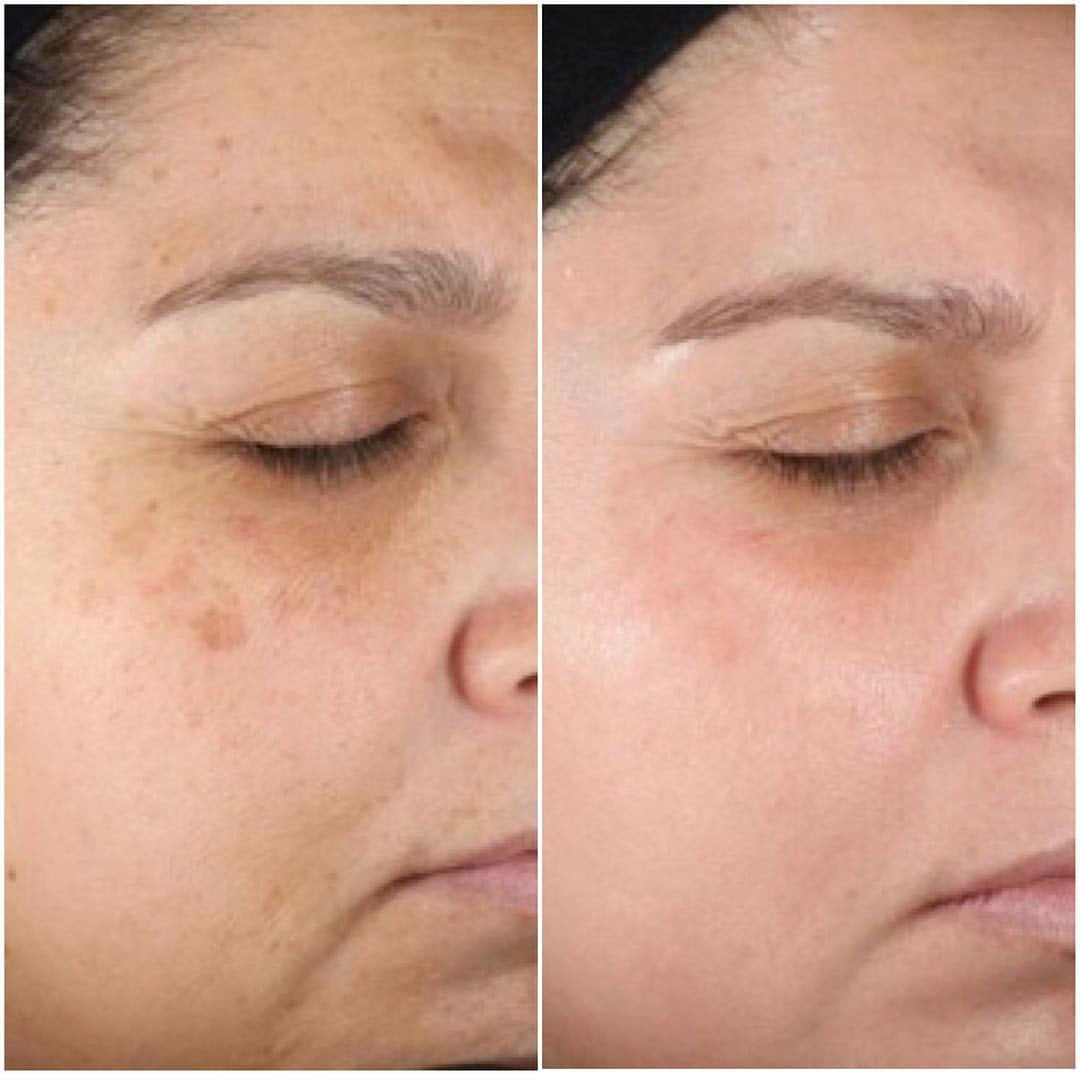



Description
Description
Walis.B's Retinol Serum is a skincare powerhouse designed to combat the signs of aging effectively. Formulated with a potent blend of ingredients, including vitamin A derivatives, it works to penetrate deep into the skin, stimulating collagen production and accelerating cell turnover. This results in visibly reduced fine lines, wrinkles, and age spots, while also improving skin texture and promoting a more even complexion. With consistent use, our retinol serum helps rejuvenate the skin, leaving it looking smoother, firmer, and more youthful. It's an essential addition to your skincare routine for achieving a radiant and age-defying complexion.
Benefits
Benefits
- Promotes collagen production
- Promotes cell regeneration
- Reduces fine lines, wrinkles and spots
- Improves skin texture
- Even out complexion
- Makes skin smooth and supple
Ingredients
Ingredients
Olive Squalene, Wheat Germ Oil (As Contained Natural Vitamin E), 2.5% Retinol, Dimethiconol.
Dos and Don’ts for Using Retinol
Dos and Don’ts for Using Retinol
Dos:
- Start Slowly: Begin with a lower concentration of retinol to assess how your skin responds. Gradually increase the strength and frequency as your skin adapts.
- Apply at Night: Use retinol in your nighttime routine since it can make your skin more sensitive to sunlight.
- Use Sunscreen: Apply a broad-spectrum SPF of at least 30 during the day to protect your skin from UV damage and avoid irritation.
- Moisturize: Use a hydrating moisturizer to help prevent dryness and peeling associated with retinol use.
- Patch Test: Perform a patch test before using retinol extensively to check for adverse reactions.
- Cleanse Gently: Use a mild, non-exfoliating cleanser before applying retinol to avoid additional irritation.
- Consult a Professional: Speak with a dermatologist if you have specific skin concerns or conditions to tailor retinol use appropriately.
- Use the Sandwich Method: To minimize irritation, apply a moisturizer before and after retinol (e.g., apply a layer of moisturizer, then retinol, followed by another layer of moisturizer). This helps buffer the retinol and can reduce dryness and irritation
Don’ts
- Avoid Overuse: Don’t use retinol more often than recommended. Overuse can lead to excessive dryness and irritation.
- Don’t Combine with Harsh Ingredients: Avoid using retinol with other strong actives like AHAs, BHAs, or vitamin C in the same routine to prevent irritation.
- Skip the Sun: Never skip sunscreen during the day as retinol increases sun sensitivity.
- Don’t Apply to Broken Skin: Avoid applying retinol to areas with cuts, burns, or other forms of broken skin.
- Avoid Immediate Makeup Application: Allow a few minutes for retinol to absorb before applying makeup to minimize irritation.
- Don’t Over-Exfoliate: Limit the use of other exfoliants to avoid excessive dryness and irritation.
Additional Considerations
Additional Considerations
- Pregnancy and Lactation: Pregnant or lactating women should avoid using retinol. High doses of vitamin A (retinol is a derivative) have been linked to birth defects. It’s best to consult with a healthcare provider for alternative skincare options.
- Facial Hair and Shaving (for Men): Men with facial hair should apply retinol carefully to avoid irritation. If you shave regularly, wait until your skin has settled before applying retinol.
These guidelines should help ensure you use retinol effectively and safely. If you have specific concerns or conditions, it’s always best to seek personalized advice from a dermatologist.
Common Considerations for Both Genders
Common Considerations for Both Genders
- Skin Sensitivity: Both men and women should be mindful of their skin’s sensitivity when starting retinol. Gradual introduction is key to minimizing irritation.
- Sun Protection: Regardless of gender, applying sunscreen is crucial because retinol increases sun sensitivity.
- Moisturization: Hydration is important for everyone using retinol to counteract potential dryness and irritation.
- Avoiding Harsh Ingredients: Both men and women should avoid combining retinol with other potentially irritating ingredients to prevent excessive dryness or irritation.
Gender-Specific Considerations
Gender-Specific Considerations
- Facial Hair: For men, facial hair can impact the application and absorption of retinol. If you have facial hair, make sure to apply retinol carefully to avoid irritation in those areas.
- Skin Concerns: Men and women might have different skin concerns or conditions. For instance, men may experience more oiliness or acne, while women might be more focused on anti-aging. Tailoring retinol use to address specific concerns can be beneficial.
- Shaving: Men who shave regularly should be particularly cautious with retinol. Shaving can make skin more sensitive and prone to irritation, so it might be best to apply retinol on nights when you haven’t shaved or use it after allowing any irritation from shaving to subside.
Overall, the fundamental principles of using retinol—such as starting slowly, moisturizing, and using sunscreen—apply universally. Adjustments might be necessary based on individual skin characteristics and grooming habits.
Cautions
Cautions
- Prevent contact with eyes
- If contact occurs, rinse eyes thoroughly with water.
- Store below 30°C and shield from direct sunlight.
- Keep out of reach of children.
- Discontinue use if skin irritation, rashes, or allergies occur.
FAQs
FAQs
WHEN SHOULD I APPLY RETINOL SERUM IN MY ROUTINE?
Retinol Serum is your PM ‘Treat’ step. Layer Retinol Serum as your last treatment and follow up with a moisturizer.
HOW TO APPLY A RETINOL SERUM?
The best way to go about it is by washing your face first and applying eye cream to help protect the skin around the eyes. Wait for a few minutes until your skin is completely dry and take a pea-sized amount of serum. Use your fingertips and start at the chin and apply in upward and outward motions.
HOW OFTEN SHOULD I USE IT?
Start of with 1-2 times per week and increase gradually if your skin can tolerate more frequent use.
WHY CAN'T I USE RETINOL SERUM IN THE MORNING?
As Retinol speeds up skin renewal, newer skin reaches the surface quicker. This can increase the skin's sensitivity to the sun. That's why we recommended only using Retinol Serum in the PM and always using a broad spectrum sunscreen during the day.
SHOULD I FOLLOW WITH A MOISTURIZER?
Yes, it is important to use the moisturizer. This is due to the fact that Retinol Serum can have drying effects on our skin. If you’re only just starting out and your skin is on a sensitive side, opt for the sandwich method which is apply a layer of moisturizer, then apply Retinol serum and apply another layer of moisturizer on top to minimise the risk of dehydration.
WHEN USING WITH OTHER ACTIVE INGREDIENTS
We do not recommend using Retinol Serum and Vitamin C at the same time. It is best to use Retinol in the PM. So, if using a Vitamin C, we would recommend using this in the morning. If you are also using AHAs (Glycolic Acid, Alpha Hydroxy Acid, Lactic Acid, Mandelic Acid etc), BHAs or PHA Toner in your evening routine, and want to add Retinol Serum, we suggest using these on alternate evenings and ensuring you start off slowly to ensure you do not sensitise the skin.
WHY DO I NEED TO WEAR SUNSCREEN WHEN USING RETINOL SERUM?
Due to the exfoliating properties of Retinol Serum, and the fact it increases skin renewal, means the top layer of skin is newer and potentially more sensitive to sunlight. So we always recommend using in the PM and wearing a broad spectrum sunscreen during the day.
IS IT SUITABLE FOR SENSITIVE SKIN?
If your skin is on the sensitive side we would not recommend Retinol Serum. We recommend patch testing before just to be on the safe side in case any irritation occurs. To patch test, apply a small amount of product to your inner arm and wait 24/48 hours to see if any irritation occurs.
I AM EXPERIENCING SOME IRRITATION WHILE USING THIS RETINOL SERUM, DO YOU HAVE ANY TIPS?
Start off using it 1-2 times per week and increase gradually if your skin can tolerate more frequent use. If you have more sensitive skin, use Niacinamide before Retinol Serum to help decrease irritation.
WHEN SHOULD I START USING RETINOL SERUM?
We recommend starting at age 25, when skin cell turnover starts to slow.
CAN RETINOL SERUM HELP WITH ACNE SCARS?
With properties of increasing cell turnover, and improving texture, Retinol can help to reduce discolouration left from acne. It’s important to understand what type of scarring you have before treating with Retinol so we would recommend to visit your doctor/ dermatologist.
I’M NOTICING MY SKIN IN PURGING WHEN I STARTED USING RETINOL SERUM, HOW LONG WILL IT LAST?
Purging can take up to 4- 6 weeks. During this period it is important to maintain consistent usage and keep the skin hydrated. It’s important to ensure you are using the right cleanser and moisturizer to keep your skin balanced. Using serums like Niacinamide can also help to restore and balance your skin. If your purge lasts longer than six weeks, discontinue use and seek medical advice.HOW LONG DOES IT TAKE TO SEE RESULTS?
Retinol Serum can take up to six weeks to show results. This is due to the time it takes for your skin cells to be replaced. Consistency is key, so continue with you routine even if you’re not seeing the effects straight away. It can be very tempting to increase use of some products to try and see quicker results, don't overdo it though. More is not always better change for future. Overuse can cause irritation and sensitivity.
IS IT PREGNANCY SAFE?
We do not recommend this product if pregnant or breastfeeding, consult your doctor before use.
CAN I USE THIS WITH PRESCRIPTION MEDICATION?
We would suggest you consult with your doctor to be sure.
WHEN ADDING NEW PRODUCTS TO YOUR SKINCARE ROUTINE, WE ALWAYS RECOMMEND PATCH TESTING. Learn how to patch test.






 All Skin Types
All Skin Types Cruelty Free
Cruelty Free Recyclable
Recyclable Vegan
Vegan Travel Size
Travel Size Fragrance Free
Fragrance Free